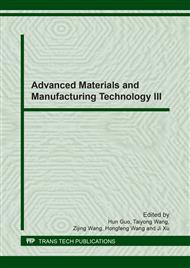p.123
p.133
p.142
p.156
p.164
p.174
p.184
p.194
p.201
Influence of Nano Al2O3 Particles on Morphology and Microstructure of Cu-Al2O3 Composite Coating by Jet Electrodeposition
Abstract:
Jet electrodeposition process is a very promising method in fabricating metal matrix composites reinforced with ceramic particles. In use of this method, insoluble particles suspended in an electrolytic bath are impinged onto and embedded in a growing metal layer. This paper is focused on the investigations of the copper matrix nanocomposite coatings with hard Al2O3 nanoparticles, electrochemically deposited from jet-circulated baths on 304 stainless steel substrate. The Cu-Al2O3 composite coating was characterized by scanning electron microscopy (SEM) and X-ray diffraction (XRD) analysis. The effects of electrolyte jet velocity, current density, addition amount of Al2O3 in the electrolyte were analyzed on the microstructure change, surface morphology change as well as codeposited content of Al2O3 particles in the composite coating. It was found that increasing content of Al2O3 particles in electrolyte may improve composite coating surface morphology and increase the practical current density by exerting impingement effect on the cathode deposit surface, till excessive Al2O3 e.g.20g/L particles was added. Besides, appropriate amount of nanoparticles in the electrolyte also could offer grain refinement by providing nanocrystalline sized between 30~60 nm with current density in the range of 100~500 A/dm2.
Info:
Periodical:
Pages:
164-173
Citation:
Online since:
February 2018
Authors:
Price:
Сopyright:
© 2018 Trans Tech Publications Ltd. All Rights Reserved
Share:
Citation:


